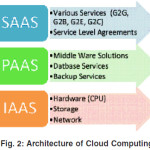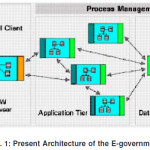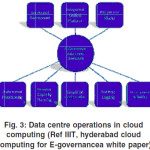Application of Cloud Computing for the Better E-Governance in Developing Countries
Introduction
(Rastogi 2010) Discusses the various problems that has been identified in implementing the various phases of the E-governance in developing countries. The Main problems that he had discussed are Infrastructure Development, Accessibility, Security, Trust & Privacy, Transparency, Permanent Availability and Preservation, Cost Structures. The following section discusses the Traditional architecture of the E-governance and the various problems in this Architecture.
Problems with present Architecture
Application Life Cycle Management cost-effective management of structured data throughout and testing to archiving and retirement replication facility needs to be provided and it’s cumbersome. It may cause duplication of resource and departments. As the complexity and sophistication of the software development task has grown it needs to use increasing numbers of tools.
Software licensing and Support application the licensing is required application is sufficient enough. Scalability: Traditional infrastructure to frequently upgrade to meet these challenges, software redundant.
Accountability the applications in traditional infrastructure don’t have accountability.
Modifiability traditional infrastructure example as they are not inherently scalable the provisioning cost and time for moving from 100 users to 10000
Physical security
It involves the provision of safe activities with a focus on preventing unauthorized physical access to computing equipment. includes:
Threats and facility requirements,
Personnel physical access control, and
Microcomputer physical security
Traditional Infrastructure
With traditional infrastructure, we need to ensure secure, application life, from development retirement. For making the application highly available, the part of development activity which could be resources across various government organizations support: It is another major concern as for each but for distributed data centers only one license for the application cannot scale, scalability demands change over time. thereby making some of the hardware and central authority and traditional infrastructure incurs more costs when modification is required.
Introduction to Cloud Computing
According to National Institute of Standards and Technology, USA (NIST) Definition of Cloud Computing is :
Definition
Cloud computing is a model for enabling ubiquitous, convenient, on demand network access to a shared pool of configurable computing resources (e.g., networks, servers, storage, applications, and services) that can be rapidly provisioned and released with minimal management effort or service provider interaction.
Cloud computing encompasses a whole range of services can be hosted in a variety of manners, depending on the nature of the service involved and the data/security needs of the contracting organization.
However, the basic idea behind the cloud model is that anything that could be done in computing — whether on an individual PC or in a corporate data center — from storing data to collaborating on documents or crunching numbers on large data sets can be shifted to the cloud. Certainly, cloud computing enables a new platform and location-independent perspective on how we communicate, collaborate and work. So long as you can access the Web, you are able to work when and where you wish. With fast, reliable Internet connectivity and computer power, it does not matter where the document, the e-mail or the data the user sees on the screen comes from. Cloud computing enables providers to use distant data centers for cloud computing. Still, while some have predicted the end of the PC era with the rise of the cloud computing model, many believe that most organizations and even individuals will continue to make use of traditional PCs and laptops, even if more and more of their use will be to access the cloud [3].
For individuals, cloud computing means accessing web-based email, photo sharing and productivity software, much of it for free [4]. For organizations, shifting to the cloud means having the ability to contract for computing services on-demand, rather than having to invest to host all the necessary hardware, software and support personnel necessary to provide a given level of services [5]. And for governments, the value proposition of the cloud is especially appealing, given both changing demands for IT and challenging economic conditions [6]. See below the Fig 2, Architecture of Cloud Computing for E-governance (Ref IIIT, Hyderabad Cloud Computing for E- Governance A white paper) In cloud computing generally we have to define three delivery models
Software as a Service (SaaS)
The consumer uses an application, but does not control the operating system, hardware or network infrastructure on which it’s running. The capability provided to the consumer is to use the provider’s applications running on a cloud infrastructure. The applications are accessible from various client devices through a thin client interface such as a web browser (e.g., web-based email). The consumer does not manage or control the underlying cloud infrastructure including network, servers, operating systems, storage, or even individual application capabilities, with the possible exception of limited user specific application configuration settings.
Platform as a Service (PaaS)
The consumer uses a hosting environment for their applications. The consumer controls the applications that run in the environment (and possibly has some control over the hosting environment), but does not control the operating system, hardware or network infrastructure on which they are running. The platform is typically an application framework. The capability provided to the consumer is to deploy onto the cloud infrastructure consumer-created or acquired applications created using programming languages and tools supported by the provider. The consumer does not manage or control the underlying cloud infrastructure including network, servers, operating systems, or storage, but has control over the deployed applications and possibly application hosting environment configurations.
 |
Figure 3: Data centre operations in cloud computing (Ref IIIT, hyderabad cloud computing for E-governancea white paper)
Click here to View figure
|
Infrastructure as a Service (IaaS)
The consumer uses “fundamental computing resources” such as processing power, storage, networking components or middleware. The consumer can control the operating system, storage, deployed applications and possibly networking components such as firewalls and load balancers, but not the cloud infrastructure beneath them. The capability provided to the consumer is to provision processing, storage, networks, and other fundamental computing resources where the consumer is able to deploy and run arbitrary software, which can include operating systems and applications. The consumer does not manage or control the underlying cloud infrastructure but has control over operating systems; storage, deployed applications, and possibly limited control of select networking components (e.g., host firewalls).
Implementation Models
The following section 5 will discuss the implementation models of cloud computing for E- governance
Public Cloud
In simple terms, public cloud services are characterized as being available to clients from a third party service provider via the Internet. The term “public” does not always mean free, even though it can be free or fairly inexpensive to use. A public cloud does not mean that a user’s data is publically visible; public cloud vendors typically provide an access control mechanism for their users. Public clouds provide an elastic, cost effective means to deploy solutions.
Private Cloud
A private cloud offers many of the benefits of a public cloud computing environment, such as being elastic and service based. The difference between a private cloud and a public cloud is that in a private cloud-based service, data and processes are managed within the organization without the restrictions of network bandwidth, security exposures and legal requirements that using public cloud services might entail. In addition, private cloud services offer the provider and the user greater control of the cloud infrastructure, improving security and resiliency because user access and the networks used are restricted and designated.
Community Cloud
A community cloud is controlled and used by a group of organizations that have shared interests, such as specific security requirements or a common mission. The members of the community share access to the data and applications in the cloud.
Increased Flexibility
On-demand computing across technologies, business solutions and large ecosystems of providers; reduced new solution implementation times.
Access anywhere
The services will accessed from a single computer or network. Use different computer or move to portable devices, and applications and documents follow.
Elastic scalability and pay-as-you-go
Add and subtract capacity as your needs change. Pay for only what you use.
Easy to implement
No need to purchase hardware, software licenses or implementation services.
Service quality
Reliable services, large storage and computing capacity, and 24X7 service and up-time.
Delegate non-critical applications Outsourcenon-critical applications to service providers and focus agency IT resources on business-critical applications.
Always the latest software
Hybrid Cloud
A hybrid cloud is a combination of a public and private cloud that interoperates. In this model users typically outsource non business- critical information and processing to the public cloud, while keeping business-critical services and data in their control.
Advantages of Cloud Computing Significant Cost Reduction
As discussed in section 1 the cost of implementing the E-governance is very high but in cloud computing available at a fraction of the cost of traditional IT services; upfront capital expenditures eliminated; dramatically reduced IT administrative burden Updates are automatic in cloud computing.
Private Public Partnership
Applications and documents accessible from anywhere in the world, facilitating group collaboration on documents and projects.
Conclusion
The conclusion drawn from the above research is that we can provide the better facilities to the citizens of the developing countries at a very low cost. They can easily implement or enhance their services in education, healthcare and social upliftment of the citizens.
References
- Gartner, Press Release: Gartner says cloud computing will be as influential as e-businessSpecial report examines the realities and risks of cloud computing (2008).
- C. Johnson, “CIO technology survey results,” CIO, (2009).
- D.C. Wyld, Moving to the cloud: An introduction to cloud computing in government. Washington, DC: IBM Centerfor the Business of Government, (2009).
- M. O’Gara, “Washington itching to take the lead on cloud computing,” SOA Journal, (2009). [Online].
- IDC, Press Release: IDC Finds Cloud Computing Entering Period of Accelerating Adoption andPoised to Capture IT Spending Growth Over the Next Five Years, (2008).
- S. Hamm, “How cloud computing will change business,” Business Week, (2009).
- G. Nagesh, “Agencies predicted to move to cloud computing cautiously,” NextGov, April 22 (2009).
- G. Nagesh, “USA.gov’s successful shift to cloud computing could become the model,” NextGov, September 29 (2009).
- S. Towns, “Federal web portal moves to cloud computing platform,” Government Technology,May 1 (2009).
- D. Stegon, “Vivek: One stop cloud shop,” Washington TechBisNow, July 16 (2009).
- National Aeronautics and Space Administration (NASA), “About the NEBULA cloud,”
- N. Atkinson, “NASA creates a new NEBULA: Cloud computing project,” Universe Today, June 4 (2009).
- National Aeronautics and Space Administration (NASA), “NEBULA services,”
- S. Lohr, “I.B.M. to help clients fight cost and complexity,” New York Times, June 15 (2009).
- G. Gross, “Gov’t agencies embrace cloud computing: Government agencies say they’re moving toward an embrace of cloud computing and software-as-a-service,” PC World, February 25 (2009).
- Government of the United Kingdom, Department for Business Innovation & Skills and Department for Culture, Media and Sport, Press Release: Building Britain’s Digital Future, June 16 (2009).
- Government of Denmark, IT and Telecom Agency, Press Release: Launching a dialogue on cloud computing in government,July 17, (2009).
- A. DiMaio, “Is there a European government cloud?” Gartner, May 19 (2009).
- R. Hicks, “The future of government in the cloud,” FutureGov, 6(3): 58-62 (2009).
- D. Rosenberg, “Supercloud looms for Japanese government,” CNet News, May 14 (2009).
- R. Hicks, “Chinese city builds public cloud to aid innovation,” FutureGov, September 29 (2009).
- IBM, White Paper – Seeding the Clouds: Key Infrastructure Elements for Cloud Computing, (2009).
- C. Babcock, “IBM talks up cloud computing: ‘Cloud computing is a new way of consuming IT,’” InformationWeek, June 27 (2009).
- T.P. Strecker, “Govt IT procurement in for shake-up,” The Dominion Post, June 22 (2009).
- J.F. Rayport and A. Heyward, White paper: Envisioning the cloud: The next computing paradigm, a Marketspace point of view, March 20 (2009).
- J. Erlichman, “Special report: Cloud computing,” 1105 Media, (2009).
- J. Jackson, “New metrics needed for cloud computing,” Government Computer News, July 30 (2009).
- B. Gardiner, “The future of cloud computing: A long-term forecast,” Portfolio, March 9 (2009).
- B. Robinson, “3 steps to lift the cloud,” Federal Computer Week, January 12 (2009).
- B. Golden, “The case against cloud computing, part one,” CIO, January 22 (2009).
- L. Cureton, “Cloud computing in the federal government: On a cloudy day how it will astound you,” Goddard CIO Blog, March 14, (2009). [Online]. Available: http:// blogs.nasa.gov/cm/blog/Goddard-CIO-Blog.blog/posts/post_1237089048316.html J. King, “5 key questions about cloud storage,” Computerworld, July 13 (2009).
- D. Beizer, “Cloud computing comes into focus,” Government Computer News, June 11 (2008).
- K. Melymuka, “The end of corporate IT: Nicholas Carr is at it again. This time, he envisions a future where IT has gone the way of the electric generator,” Computerworld, May 9 (2005).
- Rastogi A, “E-Governance in India : Challenges and Opportunities”, unpublished 2010. National Institute of Standards and Technology (NIST) Definition of Cloud Computing, http://csrc.nist.gov/groups/SNS/ cloud-computing/ http://sites.google.com/a/ bah.com/government-cloud-computing/files

This work is licensed under a Creative Commons Attribution 4.0 International License.



